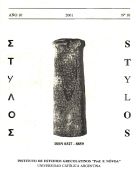Please use this identifier to cite or link to this item:
https://repositorio.uca.edu.ar/handle/123456789/3994| Título: | Il tema del sorriso dalla bibbia alla patristica greca : un'indagine preliminare | Autor: | Ramelli, Ilaria | Palabras clave: | LITERATURA CLASICA; Biblia N.T. Hechos de los Apóstoles; LITERATURA GRIEGA; RISA; ANALISIS TEXTUAL; PATRISTICA | Fecha de publicación: | 2006 | Editorial: | Universidad Católica Argentina. Facultad de Filosofía y Letras. Instituto de estudios grecolatinos "Prof. F. Nóvoa" | Cita: | Ramelli, Ilaria. “Il tema del sorriso dalla bibbia alla patristica greca : un'indagine preliminare” [en línea], Stylos, 15 (2006). Disponible en: https://repositorio.uca.edu.ar/handle/123456789/3994 | Resumen: | Riassunto: Dopo avere presentato un breve status quaestionis degli studi sul tema del sorriso nel mondo classico, iI contributo lo analizza nel mondo biblico e cristiano antico: nelIa Septuaginta si rileva una sola occorrenza canonica del lessico del sorriso e una deuterocanonica, nei libri piu recenti ed "ellenizzati" (4Mac e Sir); nessuna e nel Nuovo Testamento. Questo probabilmente determino, almeno nei primi secoli, un uso relativamente scarso di questo lessico presso gli autori cristiani, che vengono analizzati dopo i giudeo-ellenisti Filone e Giuseppe, che presentano un uso cospicuo e differenziato. Tra i Cristiani, fomiscono interessanti esempi gli Atti di apostoli e martiri, dove il sorriso esprime spesso la superiorita dell'eroe nel dibattito con i suoi interlocutori o di fronte alla morte. Giustino attribuisce un sorriso garbato ma non convinto soltanto a Trifone; in Clemente si ha la prima teorizzazione del sorriso, ispirata al passo del Siracide, e Origene utilizza per primo un riferimento al sorriso entro l'aneddotica pagana del saggio superiore alle torture. L'origeniano Gregorio di Nissa, che ha ben otto occorrenze del sorriso, associa anch'egli sorriso e apatheia nel tratteggiare il fratello Basilio o nei neonati, e vede iI sorriso come segno di cordialiti e convivialiti, o lo interpreta allegoricamente. Abstract: After a brief status quaestionis on scholarship conceming the theme oí smile in the classical world, this theme is examined in the Bíblical and early Christian literature: in the Septuagint, the terminology oí smile appears only in 4Mac and Sir, two late and Hellenized books, only the second of which is canonical. In the New Testament there is no occurrenee at aH. This probably determined, at least in the first centuries, a relatively scaree use of this terminology in the Christian authors, who are investigated after the Jewish-HeIlenistic Philo and Josephus, who offer a remarkable number and variety oí instances. Among the Christians, interesting examples are to be found in the Acts of apostles and martyrs, where the smile often expresses the hero's superiority in the debate with his opponents or when facing death. In Justin, a polite smile is attributed to Trypho; Clernent is the first who specificalIy reflects on smile, drawing inspiration from Ben Sirach, and Origen refers to the smile in connection with the tradition of thepagan sage and his superiority to torments, as a clear sign of apatheia. Gregory ofNyssa, who often depends on Origen, presents eight occurrences ofthe smile terminology, he too Iinks smile and apatheia in his portrait ofBasil, or in babies, and sees the smile as a sign of cordiaJity and sober cheer in banquets, or else he interprets it allegorically. |
URI: | https://repositorio.uca.edu.ar/handle/123456789/3994 | ISSN: | 0327-8859 | Disciplina: | LITERATURA | Derechos: | Acceso Abierto | Fuente: | Stylos Nº 15, 2006 |
| Appears in Collections: | STY - 2006 nro. 15 |
Files in This Item:
| File | Description | Size | Format | |
|---|---|---|---|---|
| sorriso-dalla-bibbia-patristica.pdf | 1,12 MB | Adobe PDF |  View/Open |
Page view(s)
121
checked on Apr 27, 2024
Download(s)
217
checked on Apr 27, 2024
Google ScholarTM
Check
This item is licensed under a Creative Commons License

